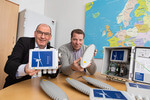07/17/2011
Special Report - Wireless data radios versus wired solutions for wind turbine monitoring
Wind-farm operators are looking for the best ways to prevent failures while maintaining turbines. One way is to help O&M teams detect problems as soon as possible and avoid possible disasters. Vibration, one of the best indicators of potential problems, is often monitored in the nacelle. Vibration monitoring gives O&M companies and technicians a predictive tool to look for problems before they arise. For example, a vibration reading can tell an operator that a blade is coming loose, thereby allowing preventive action to avoid damages that could tally into the millions.
Vibration monitoring
A common monitoring solution wires certain equipment in the nacelle. Many operators, however, find it is unfeasible to install additional wire. This is more true for turbines in remote locations and for the high costs associated with installing additional wire. Sometimes, it’s simply not possible to run wire back to the O&M office.
In these situations, wireless technologies have become an option for various monitoring applications in the renewable energy industries, including wind power. Satellite systems, for example, have generally reliable broadband capabilities, but involve monthly recurring costs. Cellphone systems function in a similar fashion, use existing networks of communication devices and have monthly charges. When users are within range of a cell tower, these systems are a simple solution for sending data back to the O&M office. However, the monthly costs associated with satellite or cell phone systems become a burden on an operating budget.
More recently, operators can choose Frequency Hopping Spread Spectrum (FHSS) radios to send critical vibration data to the O&M office without the added cost of a fiber installation and monthly, or reoccurring, fees that tend to accompany cellular and satellite solutions. FHSS radios are well suited for installations in remote locations and difficult environments. They can reliably transmit real-time data up to 60 miles line-of-sight. In terms of the key drivers associated with adopting wireless technologies, the cost benefits are the most intuitive. A few other drivers include:
- Installation savings are probable because wirelessly connected assets cost as little as 10% of the wired alterative and offer faster startups and accelerated profits. In addition, engineering costs reduce significantly because extensive surveys and planning are no longer required to route wire back to junction boxes or control rooms.
-Better information comes by replacing manual readings with automated measurements that give more accurate, timely, and consistent information.
- Economy of scale allows deploying additional points to a network at incremental cost and may include integration into legacy systems.
- Operational savings come from actively focusing on condition monitoring that supports predictive maintenance. Savings also come by identifying turbine problems before they become a costly issue.
- Safer operations result when making more frequent measurements that allow early detection of issues, which helps reduce or even prevent incidents or accidents.
Evaluating the attributes of various wireless technologies allows making essential decisions that guarantee successful implementation of a wireless architecture. Attributes include the RF technology, security, interference rejection, sensitivity, and power management. Furthermore, it’s necessary to determine whether or not new systems interface with existing equipment to preserve investments in existing infrastructure. The determination might also be made with respect to the radio providers’ commitment to backward compatibility to extend the life of the system and drive down the overall lifetime cost of implementation.
Hybrid options
Hybrid networks, a blend of different technologies, are often important to consider especially in the wind-power markets. Wind installations can be remote. In such locals situations, there are benefits to implementing a system that uses data radios from location to location with a satellite modem at a site-data concentrator. Hybrid networks might also include a mix of fiber, data radios, and satellite or cell phone-based equipment. A hybrid system can be a more cost-effective and useful solution for remote networks through lower hardware costs, fewer points requiring monthly fee-based satellite or cell-connection modems, and lower power-consuming equipment.
For example, consider a 10-turbine wind farm in an isolated region. Land-line access does not exist. Cell coverage is not present, although there is satellite coverage. A viable hybrid solution would include data radios on each turbine communicating to one “master station” turbine. The radios can provide reliable communications with backwards compatibility without monthly fees. At the master station, a master radio wired to a satellite modem uplinks data to and from the wind farm.
This system eliminates monthly fees for nine of the ten towers. The ability to gather time-critical information, digest it, and react upon it is key to continuously adapting to change with increasing reliability and profitability.
No single type of wireless technology solves all problems. Therefore, it becomes important to evaluate necessary monitoring, management, and security capabilities to ensure the wireless architecture selected maximizes limited resources. At the same time, the equipment must let disparate applications share the spectrum within the context of their importance and time sensitivity.
FHSS wireless data radios can reliably serve as the Ethernet link between a wind turbine and O&M office. Wind-power companies are finding that the right wireless provider and installation can be equally effective and far less expensive than a wired solution. Reliable wireless devices are easily installed as operators inspect wind turbines nearing the end of their warranties. After deployment, the turbines get continuous real-time monitoring that indicates vibration issues before they cause damage.
For more information on this article or if you would like to know more about what www.windfair.net can offer, please do not hesitate to contact Trevor Sievert at ts@windfair.net
www.windfair.net is the largest international B2B Internet platform – ultimately designed for connecting wind energy enthusiasts and companies across the globe!
Vibration monitoring
A common monitoring solution wires certain equipment in the nacelle. Many operators, however, find it is unfeasible to install additional wire. This is more true for turbines in remote locations and for the high costs associated with installing additional wire. Sometimes, it’s simply not possible to run wire back to the O&M office.
In these situations, wireless technologies have become an option for various monitoring applications in the renewable energy industries, including wind power. Satellite systems, for example, have generally reliable broadband capabilities, but involve monthly recurring costs. Cellphone systems function in a similar fashion, use existing networks of communication devices and have monthly charges. When users are within range of a cell tower, these systems are a simple solution for sending data back to the O&M office. However, the monthly costs associated with satellite or cell phone systems become a burden on an operating budget.
More recently, operators can choose Frequency Hopping Spread Spectrum (FHSS) radios to send critical vibration data to the O&M office without the added cost of a fiber installation and monthly, or reoccurring, fees that tend to accompany cellular and satellite solutions. FHSS radios are well suited for installations in remote locations and difficult environments. They can reliably transmit real-time data up to 60 miles line-of-sight. In terms of the key drivers associated with adopting wireless technologies, the cost benefits are the most intuitive. A few other drivers include:
- Installation savings are probable because wirelessly connected assets cost as little as 10% of the wired alterative and offer faster startups and accelerated profits. In addition, engineering costs reduce significantly because extensive surveys and planning are no longer required to route wire back to junction boxes or control rooms.
-Better information comes by replacing manual readings with automated measurements that give more accurate, timely, and consistent information.
- Economy of scale allows deploying additional points to a network at incremental cost and may include integration into legacy systems.
- Operational savings come from actively focusing on condition monitoring that supports predictive maintenance. Savings also come by identifying turbine problems before they become a costly issue.
- Safer operations result when making more frequent measurements that allow early detection of issues, which helps reduce or even prevent incidents or accidents.
Evaluating the attributes of various wireless technologies allows making essential decisions that guarantee successful implementation of a wireless architecture. Attributes include the RF technology, security, interference rejection, sensitivity, and power management. Furthermore, it’s necessary to determine whether or not new systems interface with existing equipment to preserve investments in existing infrastructure. The determination might also be made with respect to the radio providers’ commitment to backward compatibility to extend the life of the system and drive down the overall lifetime cost of implementation.
Hybrid options
Hybrid networks, a blend of different technologies, are often important to consider especially in the wind-power markets. Wind installations can be remote. In such locals situations, there are benefits to implementing a system that uses data radios from location to location with a satellite modem at a site-data concentrator. Hybrid networks might also include a mix of fiber, data radios, and satellite or cell phone-based equipment. A hybrid system can be a more cost-effective and useful solution for remote networks through lower hardware costs, fewer points requiring monthly fee-based satellite or cell-connection modems, and lower power-consuming equipment.
For example, consider a 10-turbine wind farm in an isolated region. Land-line access does not exist. Cell coverage is not present, although there is satellite coverage. A viable hybrid solution would include data radios on each turbine communicating to one “master station” turbine. The radios can provide reliable communications with backwards compatibility without monthly fees. At the master station, a master radio wired to a satellite modem uplinks data to and from the wind farm.
This system eliminates monthly fees for nine of the ten towers. The ability to gather time-critical information, digest it, and react upon it is key to continuously adapting to change with increasing reliability and profitability.
No single type of wireless technology solves all problems. Therefore, it becomes important to evaluate necessary monitoring, management, and security capabilities to ensure the wireless architecture selected maximizes limited resources. At the same time, the equipment must let disparate applications share the spectrum within the context of their importance and time sensitivity.
FHSS wireless data radios can reliably serve as the Ethernet link between a wind turbine and O&M office. Wind-power companies are finding that the right wireless provider and installation can be equally effective and far less expensive than a wired solution. Reliable wireless devices are easily installed as operators inspect wind turbines nearing the end of their warranties. After deployment, the turbines get continuous real-time monitoring that indicates vibration issues before they cause damage.
For more information on this article or if you would like to know more about what www.windfair.net can offer, please do not hesitate to contact Trevor Sievert at ts@windfair.net
www.windfair.net is the largest international B2B Internet platform – ultimately designed for connecting wind energy enthusiasts and companies across the globe!
- Source:
- WPE
- Author:
- Posted by Trevor Sievert, Online Editorial Journalist
- Email:
- ts@windfair.net
- Link:
- www.windfair.net/...
- Keywords:
- wind, wind energy, wind turbine, rotorblade, awea, ewea, wind power, suppliers, manufacturerstrevor sievert























